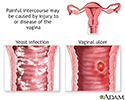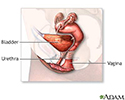Vaginismus
Sexual dysfunction - vaginismus
Vaginismus is a spasm of the muscles surrounding the vagina that occurs against your will. The spasms close the vagina and can prevent sexual activity and medical exams.
Vagina
The vagina is the female body part that connects the womb (uterus) and cervix to the outside of the body.

Causes
Vaginismus is a sexual problem. It has several possible causes, including:
- Past sexual trauma or abuse
- Mental health factors
- A response that develops due to physical pain
- Intercourse
Sometimes no cause can be found.
Vaginismus is an uncommon condition.
Symptoms
The main symptoms are:
- Difficult or painful vaginal penetration during sex. Vaginal penetration may not be possible.
- Vaginal pain during sexual intercourse or a pelvic exam.
Women with vaginismus often become anxious about sexual intercourse. This does not mean they cannot become sexually aroused. Many women with this problem can have orgasms when the clitoris is stimulated.
Exams and Tests
A pelvic exam can confirm the diagnosis. A medical history and complete physical exam are needed to look for other causes of pain with sexual intercourse (dyspareunia).
Treatment
A health care team made up of a gynecologist, physical therapist, and sexual counselor can help with treatment.
Treatment involves a combination of physical therapy, education, counseling, and exercises such as pelvic floor muscle contraction and relaxation ( Kegel exercises ).
Kegel exercises
Kegel exercises can help make the muscles under the uterus, bladder, and bowel (large intestine) stronger. They can help both men and women who have...
Vaginal dilation exercises using plastic dilators are recommended. This method helps to make the person less sensitive to vaginal penetration. These exercises should be done under the direction of a sex therapist, physical therapist, or other health care provider. Therapy should involve the partner and can slowly lead to more intimate contact. Intercourse may ultimately be possible.
You will get information from your provider. Topics may include:
- Sexual anatomy
- Sexual response cycle
- Common myths about sex
Outlook (Prognosis)
Women who are treated by a sex therapy specialist can very often overcome this problem.
References
Cowley D, Lentz GM. Emotional aspects of gynecology: depression, anxiety, PTSD, eating disorders, substance abuse, "difficult" patients, sexual function, rape, intimate partner violence, and grief. In: Lentz GM, Lobo RA, Gershenson DM, Katz VL, eds. Comprehensive Gynecology . 6th ed. Philadelphia, PA: Elsevier; 2012:chap 9.
Swerdloff RS, Wang C. Sexual dysfunction. In: Jameson JL, De Groot LJ, de Kretser DM, et al, eds. Endocrinology: Adult and Pediatric . 7th ed. Philadelphia, PA: Elsevier Saunders; 2016:chap 123.
-
Female reproductive anatomy - illustration
External structures of the female reproductive anatomy include the labium minora and majora, the vagina and the clitoris. Internal structures include the uterus, ovaries and cervix.
Female reproductive anatomy
illustration
-
Causes of painful intercourse - illustration
Dyspareunia (painful intercourse) refers to pain in the pelvic area during or after intercourse, and can occur in both women and men. Besides possible physical causes, pain may occur in association with psychological factors such as previous sexual trauma.
Causes of painful intercourse
illustration
-
Uterus - illustration
The uterus is a hollow muscular organ located in the female pelvis between the bladder and rectum. The ovaries produce the eggs that travel through the fallopian tubes. Once the egg has left the ovary it can be fertilized and implant itself in the lining of the uterus. The main function of the uterus is to nourish the developing fetus prior to birth.
Uterus
illustration
-
Female reproductive anatomy (mid-sagittal) - illustration
The female reproductive and urinary systems.
Female reproductive anatomy (mid-sagittal)
illustration
-
Female reproductive anatomy - illustration
External structures of the female reproductive anatomy include the labium minora and majora, the vagina and the clitoris. Internal structures include the uterus, ovaries and cervix.
Female reproductive anatomy
illustration
-
Causes of painful intercourse - illustration
Dyspareunia (painful intercourse) refers to pain in the pelvic area during or after intercourse, and can occur in both women and men. Besides possible physical causes, pain may occur in association with psychological factors such as previous sexual trauma.
Causes of painful intercourse
illustration
-
Uterus - illustration
The uterus is a hollow muscular organ located in the female pelvis between the bladder and rectum. The ovaries produce the eggs that travel through the fallopian tubes. Once the egg has left the ovary it can be fertilized and implant itself in the lining of the uterus. The main function of the uterus is to nourish the developing fetus prior to birth.
Uterus
illustration
-
Female reproductive anatomy (mid-sagittal) - illustration
The female reproductive and urinary systems.
Female reproductive anatomy (mid-sagittal)
illustration
Review Date: 5/16/2016
Reviewed By: Irina Burd, MD, PhD, Associate Professor of Gynecology and Obstetrics at Johns Hopkins University School of Medicine, Baltimore, MD. Review provided by VeriMed Healthcare Network. Also reviewed by David Zieve, MD, MHA, Isla Ogilvie, PhD, and the A.D.A.M. Editorial team.




